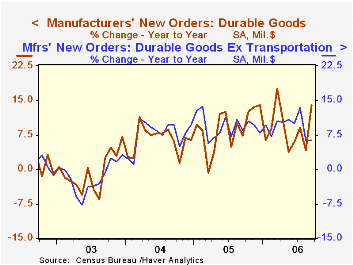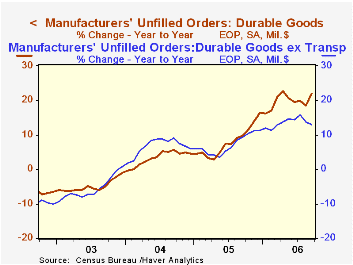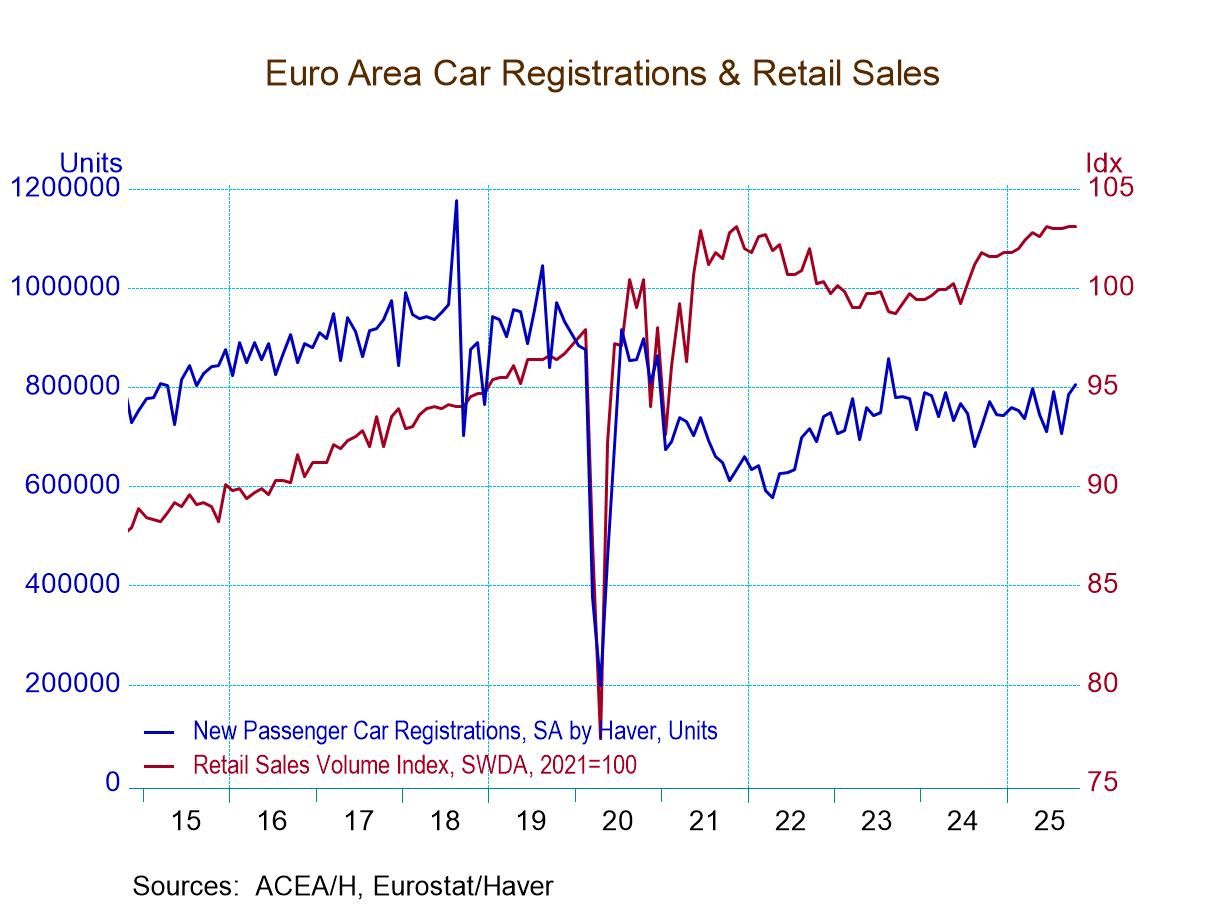 Global| Oct 26 2006
Global| Oct 26 2006Surge in U.S. Durable Goods Orders All Air
by:Tom Moeller
|in:Economy in Brief
Summary
Orders for civilian aircraft & parts nearly tripled m/m during September and propelled total new orders for durable goods up 7.8%. That followed a little revised 0.1% dip during August and it beat Consensus expectations for a 2.0% [...]

Orders for civilian aircraft & parts nearly tripled m/m during September and propelled total new orders for durable goods up 7.8%. That followed a little revised 0.1% dip during August and it beat Consensus expectations for a 2.0% increase.
During the last ten years there has been a 69% correlation between the y/y change in durable goods orders and the change in output of durable goods.
The surge in aircraft orders recovered sharp declines that had occurred during four of the prior five months while orders for motor vehicles & parts fell 6.1% (-12.0% y/y).
Durable goods orders less the transportation sector altogether ticked up just 0.1 after a 1.5% August decline. Consensus expectations had been for a 1.0% rise in orders outside of the transportation sector.
Orders for nondefense capital goods less aircraft rose 1.1% after an upwardly revised 0.8% August increase. Orders for machinery rose 1.3% (12.3% y/y) and recovered a 1.1% decline in August that was shallower than initially estimated. Electrical equipment & appliance orders recovered part of the prior month's decline with a 3.7% (0.8% y/y) gain. During the last ten years there has been an 86% correlation between the y/y change in capital goods orders less aircraft and the y/y change in business fixed investment in equipment & software from the GDP accounts.
Orders for computers & electronic products slipped 0.1% (+9.5% y/y) as computer orders fell another 2.3% (-2.4% y/y) on top of the 10.2% August skid. Orders for communications equipment fell 5.3% (+24.6% y/y).
Shipments of durable goods fell 2.8% (+4.2% y/y) and less the transportation sector fell 2.2% (+6.6% y/y). During the last ten years there has been an 82% correlation between the y/y change in durable goods shipments and the change in industrial production of durable goods.
Order backlogs surged 3.8% (21.8% y/y) and less transportation rose 1.1% (13.0% y/y). Unfilled orders for nondefense aircraft & parts jumped 7.0% (53.1% y/y).
Durable inventories rose 1.0% (7.6% y/y) after a 0.6% August rise. Less the transportation sector inventories rose 0.9% (8.3% y/y) after an upwardly revised 1.1% August gain. The inventory to shipments ratio outside of the transportation sector surged to its highest level in over a year.
Modeling the Transition to a New Economy: Lessons from Two Technological Revolutions from the Federal Resesrve Bank of Minneapolis can be found here.
| NAICS Classification | September | August | Y/Y | 2005 | 2004 | 2003 |
|---|---|---|---|---|---|---|
| Durable Goods Orders | 7.8% | -0.1% | 14.1% | 9.0% | 6.4% | -0.6% |
| Excluding Transportation | 0.1% | -1.5% | 6.2% | 9.4% | 7.6% | -1.7% |
| Nondefense Capital Goods | 21.9% | -2.2% | 34.6% | 21.4% | 5.6% | -3.4% |
| Excluding Aircraft | 1.1% | 0.8% | 10.9% | 12.3% | 2.8% | -2.0% |
Tom Moeller
AuthorMore in Author Profile »Prior to joining Haver Analytics in 2000, Mr. Moeller worked as the Economist at Chancellor Capital Management from 1985 to 1999. There, he developed comprehensive economic forecasts and interpreted economic data for equity and fixed income portfolio managers. Also at Chancellor, Mr. Moeller worked as an equity analyst and was responsible for researching and rating companies in the economically sensitive automobile and housing industries for investment in Chancellor’s equity portfolio. Prior to joining Chancellor, Mr. Moeller was an Economist at Citibank from 1979 to 1984. He also analyzed pricing behavior in the metals industry for the Council on Wage and Price Stability in Washington, D.C. In 1999, Mr. Moeller received the award for most accurate forecast from the Forecasters' Club of New York. From 1990 to 1992 he was President of the New York Association for Business Economists. Mr. Moeller earned an M.B.A. in Finance from Fordham University, where he graduated in 1987. He holds a Bachelor of Arts in Economics from George Washington University.






